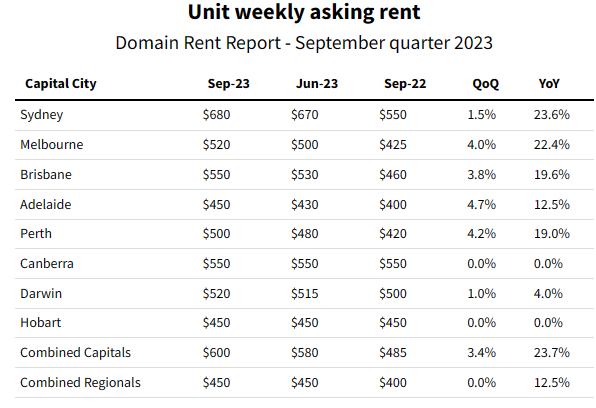CoreLogic’s latest rental vacancy data showed that vacancy rates nationally have plunged to record lows, with the capital city rate sitting at just 1.0% in September:

Source: CoreLogic
PropTrack has now released its vacancy data for September, which also shows that the national vacancy rate fell to a record low of 1.06%:

According to PropTrack:
“Rental conditions deteriorated further in September, with the proportion of rental properties sitting vacant hitting a new low”.
“Vacancy was down in both capital city and regional areas, with renters feeling the squeeze across the country”.
“Vacancy is now sitting well under 1% in three of Australia’s capital cities. More markets are expected to fall below 1% over the coming year as demand continues to grow”.
“Across Australia’s regional areas, every state has seen vacancy fall by at least 20 percentage points over the quarter”.
“Declining vacancy rates are increasing competition for rentals and placing growing pressure on rents”.
“As a result, rents are predicted to continue rising at above trend levels over the coming months, particularly in the capitals”.
The impact has seen rental inflation soar as Australians fight over the limited stock.
Unit asking rent surged by 23.7% across the capital cities in September, with the highest increases seen in Sydney (23.6%), Melbourne (22.4%), and Brisbane (19.6%), according Domain’s latest rental market report:

House rents are rising less swiftly, up 13.2% across the combined capital cities:

Dr Nicola Powell, the head of research and economics for Domain, believes that around 70,000 additional rental units are needed to restore equilibrium to the market.
Worse, Australia’s rental shortage will continue to worsen as demand via immigration continues to outrun supply:

“We need between 40,000 to 70,000 additional rentals to balance out Australia’s rental market”, Dr Powell said.
“That is like adding all of the dwellings in the LGA of Newcastle into the market”.
“This is a significant amount of rental stock needed to balance out the rental market today, and not taking into account future population growth and people arriving from overseas and people relocating”.
The Albanese Government’s record immigration program is clearly driving Australia’s rental crisis:

Reducing net overseas migration to a level below the nation’s capacity to supply housing and infrastructure is, therefore, the first best solution to the problem.
Otherwise, Australia’s housing crisis will only get worse.

